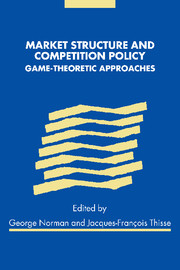Book contents
- Frontmatter
- Contents
- List of figures
- List of tables
- List of contributors
- Louis Phlips: a brief biography
- Introduction
- 1 Competition policy and game-theory: reflections based on the cement industry case
- 2 Legal standards and economic analysis of collusion in EC competition policy
- 3 A guided tour of the Folk Theorem
- 4 Predatory pricing and anti-dumping
- 5 Should pricing policies be regulated when firms may tacitly collude?
- 6 Tougher price competition or lower concentration: a trade-off for anti-trust authorities?
- 7 The strategic effects of supply guarantees: the raincheck game
- 8 Product market competition policy and technological performance
- 9 On some issues in the theory of competition in regulated markets
- 10 Modelling the entry and exit process in dynamic competition: an introduction to repeated-commitment models
- 11 Coordination failures in the Cournot approach to deregulated bank competition
- 12 How the adoption of a new technology is affected by the interaction between labour and product markets
- Index
5 - Should pricing policies be regulated when firms may tacitly collude?
Published online by Cambridge University Press: 22 September 2009
- Frontmatter
- Contents
- List of figures
- List of tables
- List of contributors
- Louis Phlips: a brief biography
- Introduction
- 1 Competition policy and game-theory: reflections based on the cement industry case
- 2 Legal standards and economic analysis of collusion in EC competition policy
- 3 A guided tour of the Folk Theorem
- 4 Predatory pricing and anti-dumping
- 5 Should pricing policies be regulated when firms may tacitly collude?
- 6 Tougher price competition or lower concentration: a trade-off for anti-trust authorities?
- 7 The strategic effects of supply guarantees: the raincheck game
- 8 Product market competition policy and technological performance
- 9 On some issues in the theory of competition in regulated markets
- 10 Modelling the entry and exit process in dynamic competition: an introduction to repeated-commitment models
- 11 Coordination failures in the Cournot approach to deregulated bank competition
- 12 How the adoption of a new technology is affected by the interaction between labour and product markets
- Index
Summary
Introduction
Regulation of the conditions under which firms compete is common in the majority of Western industrialised countries. Such regulation is intended to prevent or control, for example, explicit or tacit collusion among firms, mergers and acquisitions, vertical restraints and firms' pricing policies – in particular, whether firms can employ discriminatory pricing. The common rationale for these regulatory policies is that they are needed to protect consumers from the abuse of monopoly power by firms that supply them with goods and services.
The purpose of this chapter is to suggest that care should be exercised by anti-trust authorities in their design of policies intended to promote competition in the market place. We do not deny the underlying ‘raison d'être’ of competition policy but wish to suggest that a naive application of the idea that competition is always and everywhere desirable may have unforeseen and harmful effects. Our analysis can be summarised by the proposition that analysis of the effects of competition policy should not take industry structure as given. Policies that create too tough a competitive environment may result in perverse effects detrimental to consumer and social welfare because active anti-trust policy affects market structure through its impact on the medium- and long-run decisions of firms. The stronger are the structural effects of regulatory policy the more likely is it that blind adherence by the regulatory authorities to the benefits of competition will be misguided.
As a simple illustration, consider the case for cartel laws.
- Type
- Chapter
- Information
- Market Structure and Competition PolicyGame-Theoretic Approaches, pp. 96 - 124Publisher: Cambridge University PressPrint publication year: 2000



